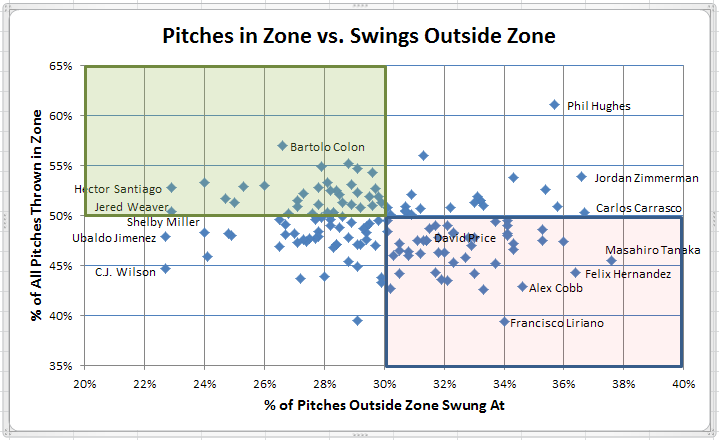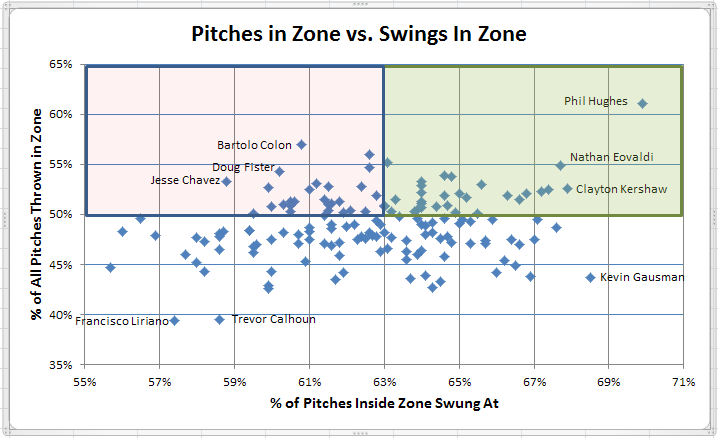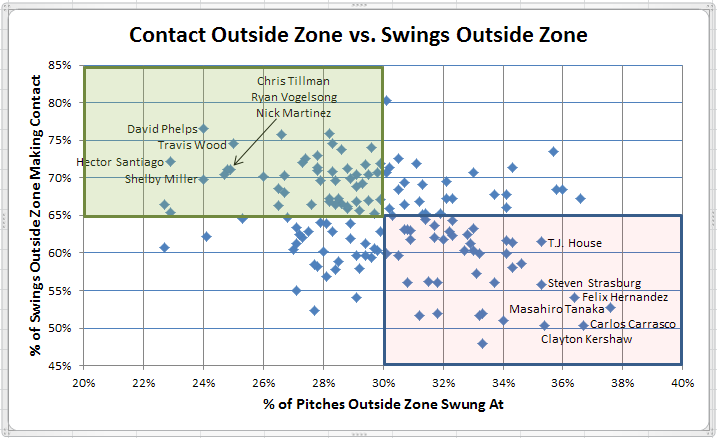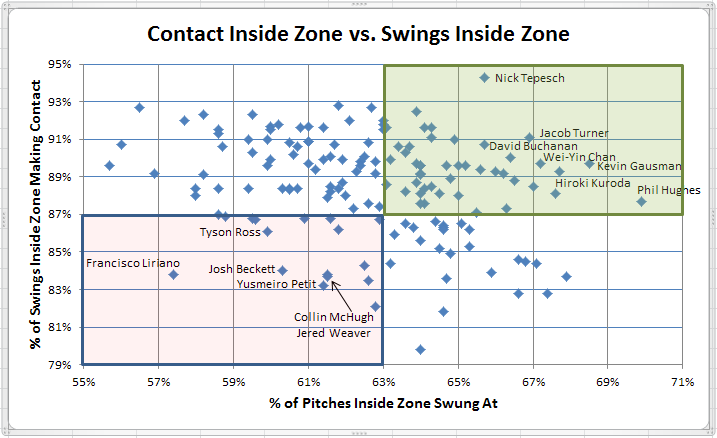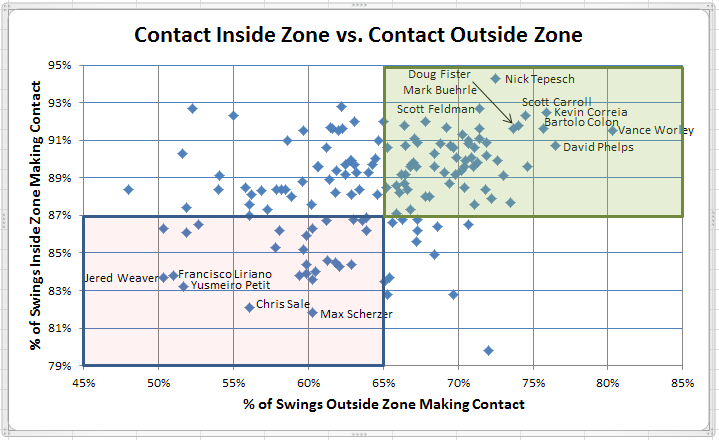Most of our readers are probably familiar with PitchFX, the computerized measurement system used by MLB to track every pitch thrown in every major league game. The system provides a wealth of statistical data, ranging from type of pitch, pitch velocity and break (vertical and horizontal) as well as pitch location and resulting swing and contact rates.
Using PitchFX data available at FanGraphs.com, I’ve compiled a series of tables and charts highlighting the 2014 pitching leaders in a variety of statistical categories. Some of the results will make a lot of sense but others may be more surprising. Take a look after the jump.
For this analysis, I’ve focused on pitchers with 100 IP in 2014. There were 149 such pitchers all of whom had at least 9 starts and 140 of which started at least 60% of their games (I’ll look at relievers in a subsequent post).
Starting with the basics, here are the top 10 and bottom 10 pitchers in pitch distribution, or % of pitches that are balls, called strikes, swinging (and missing) strikes, and pitches contacted (foul or fair). I’ve ordered the last category by highest to lowest % of pitches – I leave it to your judgment whether a high or a low number is a good or bad result.
[table id=235 /]
.
Note Phil Hughes not only taking top spot on lowest ball and highest contact rates but doing so with percentages that no other player is close to. Also interesting is the contrast between Ubaldo Jimenez and Francisco Liriano, both appearing on the lowest contact rate list but with Jimenez also on the highest called strike list while Liriano makes the highest swinging strike list. Bartolo Colon is also notable making the lowest walk, highest called strike and highest contact lists.
Next, here are the top 10 and bottom 10 in swing rates and pitches in the strike zone. Swing rates are ordered highest to lowest for pitches outside the zone, and lowest to highest for pitches in the zone. % of pitches in the zone are ordered lowest to highest – again I leave to your judgment whether a high or low result is good or bad.
[table id=236 /]
.
C.J. Wilson has a curious double, appearing on the list for lowest swing rate list on pitches both inside and outside the zone. Then again, that result may not be that surprising given the additional knowledge from the first table that Wilson had the second highest rate of pitches thrown as balls – hitters can be selective when they are frequently ahead in the count. Phil Hughes has the reverse double with batters in a veritable frenzy with everything he throws. That perhaps is explained by his top spot for the highest rate of pitches thrown in the zone (as with his appearances in the first table, in top spot by a wide margin over everyone else). You might think that, with so many pitches in the zone, hitters might wait for the one in just the right location. But, with so many inviting offerings, I suppose it’s difficult to lay off very many of them.
Among top pitchers, Felix Hernandez has the ideal profile, making the list for highest swing rate outside the zone and lowest rate inside. Clayton Kershaw has perhaps the less desirable double, making the highest rate list both inside and outside the zone, but evidently not being hurt too badly by all those swings in the zone.
Finally, here the top 10 and bottom 10 in contact rate (measured as % of swings) for pitches inside and outside the strike zone, and overall. In all cases, I’ve ordered from lowest to highest rates.
[table id=234 /]
.
As we saw in the post-season, Jusmeiro Petit just has that knack for keeping batters off-balance, as evidenced by making the lists for lowest contact rate both inside and outside the zone. Francisco Liriano is another of that mold with the lowest (by a comfortable margin) overall contact rate, a good thing considering he made the lists for highest swing rate in the zone and highest ball rate while taking top spot (perhaps not coincidentally) for the lowest proportion of offerings in the zone.
So, the tables above give some idea of the extremes in the various metrics. Those who would like to look at results for all 149 pitchers can find those data here.
To give some idea of the inter-relationship between these metrics, I’ve plotted them against each other in various combinations.
Let’s start with % of pitches in the zone compared to swing rate on pitches outside the zone. The premise here is that pitchers who can get batters to chase pitches outside the zone can pitch out there more and inside the zone less. However, those who can’t entice batters with their junk offerings will be forced to come into the zone more, often a perilous proposition.
The general trend is fairly clear – there’s an inverse relationship between swings on pitches outside the zone and pitches thrown inside the zone. I’ve highlighted red and green areas of the chart indicating, from a batter’s perspective, which are the green light pitchers and which are not, highlighting a handful of such pitchers in each group.
Next are pitches thrown inside the strike zone compared to swing rate on those pitches. From the previous chart, we saw that pitchers with lower swing rates on pitches outside the zone are forced to make more pitches inside the zone. To do that effectively, pitchers need to keep batters off balance to reduce good swings at desirable offerings. But, can they do that?
The chart above indicates that it is a rare pitcher who can keep batters off-balance that way as swing rates on pitches in the strike zone are tightly clustered in a similar pattern, regardless of how often a pitcher pitches in the zone.
Next is contact (measured as a % of swings) outside the zone vs. swings outside the zone.
The relationship here is inverse, with pitchers who can entice batters to chase pitches outside the zone achieving lower contact rates on those swings while pitchers who are less adept at tempting batters generally have higher contact rates when those batters do swing. Note that while contact may not always be bad, swinging and not making contact is still always preferable for a pitcher.
Now, the same thing for swings on pitches inside the zone. Look closely at the scales here as the ranges are quite small.
As indicated by the red area, there are very few pitchers who can limit swings in the zone AND also limit contact on those swings.
Finally, here is contact inside and outside the zone.
Most of the points are in the top half of the chart indicating that most pitchers pitch inside the zone at their peril as hitters do have a high probability of making contact with such offerings. The best pitchers have lower contact rates both inside and outside the zone while very few can combine a high contact rate outside the zone with a low rate inside the zone.
It’s your turn now. What results surprised you?

